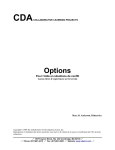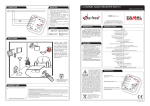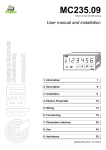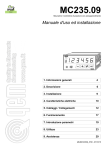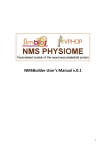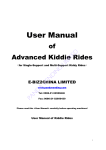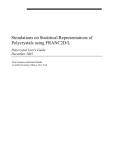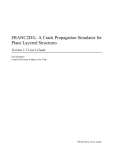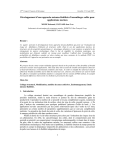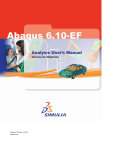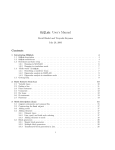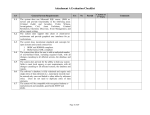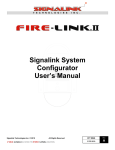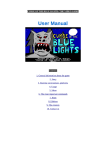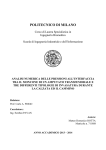Download ME EN 7960 Special topics: COMPUTATIONAL CONSTITUTIVE
Transcript
This document contains the syllabus and other first-day information for… ME EN 7960 Special topics: COMPUTATIONAL CONSTITUTIVE MODELING (Expected to be of interest to students in Bioengineering, Physics, Geophysics, Materials Science, and Metallurgy) This front page is an informal description of the course, serving as a “teaser,” to help students decide if this class is of interest. The official syllabus (draft) begins on page 2. Constitutive modeling refers to the development of equations describing the way that materials respond to various stimuli. In classical deformable body mechanics, a simple constitutive model might predict the stress required to induce a given strain; the canonical example is Hooke’s law of isotropic linear elasticity. More broadly, a constitutive model predicts increments in some macroscale state variables of interest (such as stress, entropy, polarization, etc.) that arise from changes in other macroscale state variables (strain, temperature, electric field, etc.). Constitutive equations are ultimately implemented into a finite element code to close the set of equations required to solve problems of practical interest. This course describes a few common constitutive equations, explaining what features you would see in experimental data or structural behavior that would prompt you to select one constitutive model over another, how to use them in a code, how to test your understanding of the model, how to check if the code is applying the model as advertised in its user’s manual, and how to quantitatively assess the mathematical and physical believability of the solution. The related – but fundamentally different – discipline of Materials Science aims to reveal the underlying microscale physical mechanisms (such as grain structure, dislocation density, etc.) that give rise to the relationships observed in the laboratory. Stated differently, constitutive equations predict what happens, whereas materials science explains why it happens. Materials Science plays an essential role in revealing appropriate definitions of and relationships between macroscale state variables. As such, even though this course focuses on the implementation and testing of the final equations themselves, the reasoning behind the equations (whether based on empirical observations or microscale or atomistic considerations) is essential to check the predictions and to assess if the equations are being used within their applicability domains. Working from a premise that (aside from user input typos) the largest source of error in typical engineering finite-element simulations is modeling uncertainty in the constitutive equations, this course surveys a small selection of common constitutive models as a means of illustrating principles of verification (which is evidence that the equations are solved correctly) and validation (which is evidence that the equations are realistic). Students will write their own stand-alone constitutive model driver, which will be compared with single-element testing of finite element models that purport to implement the same equations. Considerable emphasis is placed on exposing applicability limits of constitutive models. ME EN 7960 Special topics: COMPUTATIONAL CONSTITUTIVE MODELING Fall 2011, Tues & Thurs 03:40 PM-05:00 PM , WEB 1460 , 3 credit hours Course materials and assignments distributed online Instructor: Rebecca Brannon, 2134 MEB; email via course server, Cell: 801-662-8340 (use judiciously) & Thurs 5:00-6:00pm (or by appointment, or drop-in if instructor is available) Office hours: Tues Course description in catalog 7960 Special Topics (1 to 3) Prerequisites: Graduate Standing OR Instructor Consent Contemporary problems in Mechanical Engineering. Course description and prerequisites for this topics course: 7960 Computational Constitutive Modeling (3) Prerequisites: Continuum Mechanics (ME-EN 6530), PDEs (MATH 3150), Finite Element Analysis (ME-EN 6510), computer programming (in any language such as Matlab, C++, Python, FORTRAN, etc.), numerical methods, OR permission of instructor (granted if similar courses have been taken under different names). Broad theoretical and practical aspects of materials modeling illustrated through development and testing (via stand-alone driver and single-element FEM simulations) of algorithms for various commonly used material models. Emphasis is on elastic and inelastic geometric and material nonlinearity as it pertains to selecting and properly using finite element (and similar) codes. Required Textbook: A. Anandarajah, Computational Methods in Elasticity and Plasticity: Solids and Porous Media, Springer | 2010 | ISBN: 1441963782 | 685 pages | $119. Free supplemental Textbook: Schreyer, H. L., Mechanics of Inelastic Continuum, Course Notes as of 2007. [Electronic copy will be provided] Optional books: J.C. Simo and T.J.R. Hughes, Computational Inelasticity, Springer-Verlag New York | 1998 | ISBN: 00378-97520-9 | 392 pages. Ellis H. Dill, Continuum Mechanics: Elasticity, Plasticity, Viscoelasticity, CRC Press | 2006 | ISBN-10: 0849397790; ISBN-13: 978-0849397790 Grading: (H) Homework 90% (F) Final Exam (Thurs, December 15, 3:30 – 5:30 pm) 30% TOTAL= 120% minus 20% from lowest = 100% Formula: SCORE = (90H+30F – 20L) / 100, where L=min(H,F). This formula allows your better score to dominate your grade, while still requiring completion of homework and a final exam. The score is assigned a letter grade according to the following table. 0-59|60-62|63-66|67-69|70-72|73-76|77-79|80-82|83-86|87-89|90-92|93-96|97-100| E | D- | D | D+ | C- | C | C+ | B- | B | B+ | A- | A | A | The instructor reserves the right to lower the score required for any letter grade. There is no curve. Course Objectives: By the end of this course, you are expected to... 1. Understand and be able to design single-element benchmark problems that test basic principles (frame indifference, thermodynamic admissibility, basis insensitivity, etc.) that apply to any material model. 2. Write a single-element kinematics model driver capable of computing key quantities (strain, strain rate, deformation gradient, polar decomposition, Jacobian, etc.) that are typically used as input variables sent to computational constitutive models. 3. Implement stand-alone computer code for several classical constitutive models (Hooke’s law, Linear Drucker-Prager nonhardening and hardening plasticity, orthotropic composite elasticity, viscoelasticity, thermoelasticity, porosity, etc.) and test them using the single-element driver. 4. Be able to summarize seminal contributions in the literature and summarize current active research in computational constitutive modeling. Homework Policies As this is an advanced course, homework assignments will involve open-ended questions (such as estimation exercises and asking the students to come up with their own ideas for testing models). Turned in homework should be written at an advanced professional level to be expected in any 7000-level course. In particular, a homework problem will be given a grade of zero if it is incoherent or if it fails to include the following information: Problem Statement: What is given, and what is sought? Solution: word explanations must accompany each equation and the final result should be boxed. Discussion: How might the result be used? Is the answer reasonable? Discussion includes “sanity checks” that note features such as: the magnitude and sign are reasonable, the solution reduces as expected in a special case, all steps in the derivation obey indicial notation rules, the same solution is obtained in two very different ways (e.g., by hand and by using math software), the physical units are correct, etc. You can even say that your answer agrees with a similar problem found online (URL must be given) or your solution agrees with an independent analysis performed using alternative software (such as an FEM code). The use of symbolic software (Matlab, Mathematica, Maple, etc.), as well as collaboration on concepts and procedures is expected, encouraged, and occasionally even required. Collaboration does not sanction copying. You are allowed to submit only work that you have completed individually. Submitting any work that is not the result of your own effort and/or not written in your own words is considered cheating by both you and the student who allowed the work to be copied. Academic misconduct may result in a failing grade, dismissal from the program or the University, revocation of the student’s degree or certificate, or other sanctions. See the Student Handbook for further details. Late homework policy [subject to change based on discussion with students during first week of class]: Unless otherwise announced, homework is due one week after it is assigned. Late homework is not accepted. To make up for this tough stance, the following strange formula will be used: h −h , homework grade (on scale from 0 to 100) = 50 1 + − Exp H − h H where h is your total amassed homework points and H is the total number of available homework points. Suppose, for example, that you earn 74% of the available homework points (h=0.74H). Rather than getting a “C” by a conventional grading scale, the above formula would improve your homework grade to a “B”. The bonus and resubmittal policies (below) further compensate for the “no late homework” policy. Bonus policy: Can you boost your grade by doing extra work? Yes, but not at the end of the semester as a last-minute attempt to fix a low grade. Bonus points will be awarded for extra work if it is… (1) clearly beyond the scope of the assignment, (2) relevant to the assignment, and (3) handed in with the assignment. Resubmittal policy: Students may not resubmit homework to recover points lost in the first submittal except when the instructor extends an invitation to the entire class to do so. Tentative agenda (likely to change based on student interests and abilities): Week 1 (Aug 23 & 25) : Review of continuum kinematics with algorithms (such as a demonstration that iterative polar decomposition is more accurate than the exact solution, which is prone to round-off error) Homework: write the beginning of a stand-alone driver program (using any computing language approved by the student’s advisor) that takes a piecewise linear specification of deformation (an “F” table) as input and computes key kinematical quantities (Jacobian, polar decomposition, logarithmic strain, etc.) as output displayed as graphs. Week 2 (Aug 30 & Sep 1): Review of continuum stress definitions. Review of 3D linear isotropic elasticity (classical Hooke’s law) contrasted with linear isotropic Newtonian viscosity. Homework: Extend the stand-alone driver to implement Hooke’s law and test it under axial tension and compression using two different models: (1) Kirchhoff stress with logarithmic strain and (2) Second Piola-Kirchhoff stress with Lagrange strain (the latter will be exposed to be flawed since it will predict the unacceptable result that only a finite stress is required to compress the material down to zero volume). Week 3 (Sep. 6 & 8): Incremental (rate) forms of constitutive models and the use of linearization to solve nonlinear equations. Continuum strain energy. Time integration schemes and subcycling in constitutive models. Homework: Modify the stand-alone Hooke’s law model to be written in rate form that is integrated through time using an explicit time integrator. Apply it to a closed path in strain to demonstrate strain energy conservation. Week 4 (Sep. 13 & 15): Review of classical thermoelasticity and algorithms: large and small deformations. Homework: revise the Hooke’s law model to now take the temperature rate as input in addition to strain rate, and confirm that the governing equations predict analytical solutions for thermal expansion. Also implement and test a classical largedeformation hyper-elasticity model (e.g., Mooney-Rivlin). Week 5 (Sep. 20 & 22): Setting up and running constitutive model verification problems and data fitting methods in an FEM code (guest lecturer: Steve Maas, Lead developer of the University of Utah’s FEbio code) Homework: verification tests using the FEBio code at the CADE lab, and fitting of an FEbio model to actual test data. Week 6 (Sep. 27& 29): Review of basis change equations, and basis invariance requirements of constitutive models. Review of superimposed rotation and objective rates: theory and algorithms. Review of frame indifference in the context of hyperelasticity and hypoelasticity. Homework: Apply the stand-alone driver to check for consistency of Hooke’s law under basis change. Apply the standalone driver to reproduce the famous Dienes (and others) oscillating stress with Jaumann rate in hypoelasticity contrasted with hyperelasticity. Perform a literature search of recent (within the last five years) journal articles to assess the degree to which objective rates continue to be the subject of research. Week 7 (Oct. 4 & 6): Introduction to computational plasticity: non-hardening von-Mises (classical radial return algorithm). Principles of constitutive model verification testing, with emphasis on the method of manufactured solutions (MMS). Guest Lecturer: Krishna “KC” Kamojjala, who is a PhD student experienced with deriving analytical solutions to idealized plasticity problems, testing for frame indifference, and deriving body forces and tractions for the MMS. Homework: reproduce analytical results for pure shear followed by uniaxial strain. Week 8 (Oct. 18 & 20): Isomorphic projections of 6D stress space onto 2D meridional or octahedral planes. Tangent stiffness tensors in fourth-order form and in reduced matrix form using Mandel components as a preferred alternative to Voigt components. Intro to anisotropy (orthotropy and transverse isotropy). Reducing 3D constitutive models to simpler forms for verification testing. Homework: Non-computing mathematics practice with Mandel and Voigt components. Reduction to pure axisymmetric loading of an isotropic model down to a 2x2 system, again using Mandel components. Self-study introduction to isomorphic stress and strain invariants, and their relationships to more conventional invariants (such as octahedral shear stress, mean stress, von Mises equivalent stress, etc.). Week 9 (Oct. 25 & 27): Validation testing (contrasted with verification testing) leading to the need to introduce internal variables in constitutive models. Methods to develop evolution theories to match available experimental data while giving expected or desired trends where data are incomplete or not available. Case study application: classical linear and power-law isotropic hardening of von-Mises theory contrasted with kinematic hardening showing identical results in loading, but differences in unloading. Guest Lecturer: Ali Sadeghirad, research associate developing a simplified plasticity model for Uintah. Homework: Implement power law hardening into the von-Mises plasticity model via two approaches: isotropic hardening and kinematic hardening. Week 10 (Nov. 1 & 3): Computational algorithms for classical small-strain intrinsic elastic anisotropy. Homework: Implementation of a small-strain transversely isotropic elasticity model, with functional testing under simple loading (such as confirming an anisotropic stress resulting from isotropic strain), verification testing against analytical solutions for a limiting case valid for large deformations, thus showing validation limits of such models. Week 11 (Nov. 8 & 10): Continued validation critique of plasticity models revealing the need for pressure-dependent strength and apparent non-associativity. The difference between a desired (realistic) instability and an anomalous (unrealistic) instability, illustrated via the SandlerRubin instability for non-associated flow rules. Algorithms for nonassociated plasticity. Homework: Implement a non-associated linear Drucker-Prager plasticity model, and devise a way (without being told how) to verify that the nonassociative feature does reduce dilatation in uniaxial strain loading). Week 12 (Nov. 15 & 17): Softening plasticity, smeared damage and decohesion models, aleatory uncertainty, scale effects, etc. Methods for assessing rate of convergence with respect to spatial mesh resolution. Homework: Literature review to find published simulations of damage that show signs of spurious mesh dependencies. Week 13 (Nov. 22 only): Porous and granular media: stable and unstable behaviors. Stable pore crushing model, experimental evidence of nonlocal deformation (SEM images of compaction bands and shear band localization). Introduction to principles of material stability. Guest Lecture: Michael Homel Homework: cap plasticity feature in the model driver, limited to pure hydrostatic loading for tractability. Week 14 (Nov. 29 & Dec. 1): Unresolved research problems in Computational Solid Mechanics (e.g. mesh dependence, scale effects, aleatory uncertainty, spurious instabilities) Homework: none (Thanksgiving treat) Week 15 (Dec. 6 & 8): Viscoelasticity (materials with memory, Deborah number, etc.) and viscoplasticity (overstress models for high-rate loading) Homework: analytical solutions to viscoelastic models. Addition of overstress to the plasticity model driver. Important dates First lecture Mon, August 22 Last day to register without a permission code Sun, August 28 Last day to drop (delete) classes Wed, August 31 Last day to register, elect CR/NC, or audit classes Tues, September 6 Brannon at Seattle ballistics conference Thurs, Sept 22 Last day to withdraw from classes Fri, October 21 Fall break Tues & Thurs, October 11 & 13 Brannon at Barcelona Particles conference Tues & Thurs, October 25 & 27 Thanksgiving break Thurs, November 24 Last day to reverse CR/NC option Fri, December 2 Last lecture Thurs, December 8 Comprehensive final exam Thurs, December 15, 3:30 – 5:30 pm Grades Available Tues, Dec 28 NOTICES: The above dates are provided only for convenience. For official dates, refer to the 2009 academic calendar at http://www.sa.utah.edu/regist/calendar/datesDeadlines/Fall2011.htm. The instructor retains the right to revise this syllabus, with the proviso that students retain a right to reasonable notice of changes. The following COE guidelines are available at the COE website, http://www.coe.utah.edu/current-undergrad/policies_appeals.php . STUDENT SURVEY This form will be handed out two or three times during the semester. Instructions: Circle the number corresponding to your response: 1=strongly disagree 2=disagree 3=neutral 4=agree 5=strongly agree 1. The pace at which the course is proceeding is appropriate. 1 2 3 4 5 COMMENTS: 2. The prerequisites for this course are reasonable. 1 2 3 4 5 COMMENTS: 3. I (student) know the prerequisite material well enough to focus on new material. 1 2 3 4 5 COMMENTS: 4. The instructor's use of class time is effective in helping me understand the material covered. 1 2 3 4 5 COMMENTS: 5. The textbook and/or lecture notes are useful for learning the material covered. 1 2 3 4 5 COMMENTS: 6. Homework problems are assigned in proper quantities and are of proper difficulty. 1 2 3 4 5 COMMENTS: 7. The first midterm exam was a fair representation of subjects covered and was graded fairly. 1 2 3 4 5 COMMENTS: 8. The instructor is respectful when pointing out issues or problems with student performance 1 2 3 4 5 COMMENTS: 9. I believe that my knowledge of this subject will significantly help my professional career. 1 2 3 4 5 COMMENTS: 10. I (student) am happy with the effort I have put into this course to date. 1 2 3 4 5 COMMENTS: 11. I (student) am happy with my performance in this course to date. 1 2 3 4 5 COMMENTS: If I could change one thing about this course (and, of course, if I could justify the change to the taxpayers who subsidize this public institution) it would be... IS THIS SURVEY MISSING ANY IMPORTANT AREA FOR FEEDBACK? Please include additional comments, concerns, or suggestions on the back of this page. ME EN 7960 Special topics: COMPUTATIONAL CONSTITUTIVE MODELING Student information & affirmation sheet Student’s Full Name (print legibly): ________________________________________ Name I prefer to go by: ___________________________________________________ UID: _________________________________________________________________ I certify that... I have been given the course information (syllabus), which includes instructor contact information, prerequisite requirements, course objectives, evaluation methods, grading policy, course description, important dates, tentative topics list, and the College of Engineering Guidelines. I understand the course objectives that are listed in the syllabus. I understand that the instructor retains the right to revise the syllabus, with the proviso that students retain a right to reasonable notice of changes. I have satisfied the pre-requisites for taking this course as they are listed in the syllabus for this special topics course. [especially computing and continuum] I understand that I am expected to turn in homework that is professional in appearance and easy to understand by including the following information for each problem: (1) problem statement, (2) solution with words explaining each equation, and (3) discussion of the result. I understand that some homework assignments will require computer programming with math software of my choosing (Mathematica, Maple, Matlab, Python, etc.) I understand that all email communication will be sent to my university email address ([email protected]) and that it is my responsibility to ensure that that messages sent to my university email address will reach me. (OPTIONAL) What I hope to learn from this class (Grads: list areas of research that you hope will be emphasized in classroom examples and applications): (OPTIONAL) What I hope will NOT be part of this class (are there topics in the current course plan that you would prefer to drop in favor of something else?): ___________ Name __________________________________ Signature ________________ Date









